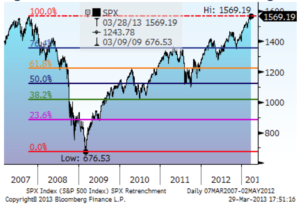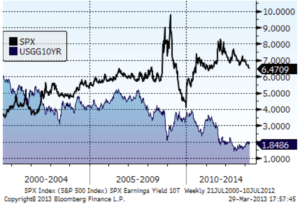Cyprus Who?
“Opportunity is not a lengthy visitor.” – Anonymous
Headlines announced a shocking development in Europe in mid-March, “unsecured depositors and unsecured debtors of Cyprus-based banks were going to lose a lot of their money”. Granted that the first round of the “troika” (ECB, IMF, and EU)1 foolishly demanded that depositors under the Euro 100,000 level would also lose money but cooler heads prevailed. Yet many still rebelled against bank investors losing any money. The natural concern was that this would be a new template for treating bank creditors elsewhere in Europe. Many are forgetting some important facts – a) banks are highly leveraged firms that can and do lose money if they are mismanaged and as with any case where assets are worth less than liabilities, someone has to pay the proverbial piper, and b) Cyprus is an economic pimple.2 Nevertheless, it was another reminder that Europe’s woes are not over, just being addressed. The Cyprus government had to get aid if it wanted to stay in the European Monetary System or face a disorderly departure (default). It remains to be seen if similar demands can be made of Italian or Spanish governments should they stray from ECB mandated austerity. So the tug of war continues between the protection of the Euro (a good outcome) and its mirror opposite – fear of systemic contagion.
Fortunately, this ten day episode offered U.S. stock markets an opportunity to consolidate early gains before resuming its seemingly inexorable climb toward record territory. The DJIA had already set and exceeded prior records and promptly marched over 14,500. The S&P closed in on its old record of 1565 on March 26 surpassing it on the 28th to close Q1 at 1569, up 10% for the quarter; a 17% climb since mid- November.
Figure 1: S&P 500 “retrenches” to Record High

[1] ECB=European Central Bank, IMF=International Monetary Fund, EU=European Union
[2] Cyprus accounts for less than 0.2% of euro-zone’s output
Too far too fast?
The S&P 500 has indeed come a long way but is merely back to where it was six years ago and aggregate earnings are up over 15% since then. One simple measure, P/E (price/earnings), is at 15.4x, still below its long run average of 16x. Moreover, the relatively unattractive low interest rate environment still favors stocks. Yes, the market will undoubtedly undergo a correction (euphemism for a 10%+ drop) but we think it is likelier to rise than fall over the next couple of years until investor expectations get too rosy again. While stocks are, by definition, not as cheap as they were four months ago, bonds are still expensive. One favored comparison, the Fed Model is shown in Figure Two highlighting the relative position of stock yields (E/P – what yields would be if the S&P 500 companies paid out 100% of earnings) and the 10 year Treasury note yield. Reasonable valuations, liquid and relatively conservative corporate balance sheets, and unattractive alternatives support current and prospectively higher stock prices.
Figure 2: S&P 500 Earnings Yield vs. 10yrTsy

Bonds remain risky
As shown above, the Fed Model indicates that bond yields are too low. Our clients will not be surprised to hear us (again) warning about the adversely skewed return profile of Treasury and long term municipal bonds at their current prices/yields. The Federal Reserve is intent on keeping rates low as long as necessary to reduce the above-average unemployment rate. Furthermore, and in spite of our government’s fiscal mess, the US is still seen as the “safe” country when geopolitical risks abound. Though low rates may stay with us for a while, eventually they will spring higher from today’s artificially low levels. A chorus of regrets will ensue from those who didn’t refinance their mortgages and those who chased yield by holding too many long maturity bonds. As sure as night follows day, bond prices move inversely to interest rates. The sensitivity of that price move is measured by its duration (the volatility of its price to changes in rates). This sensitivity is worse this time around as many bonds carry “call” features. Many longer maturity bonds are callable – that means that the issuer can redeem the bonds after set dates and at set prices. When rates are low, bonds are priced to their call date/price since they are likely to be retired at the specified call date and price (the issuer would sell new bonds in the market at low rates to pay off the old ones). But if interest rates climb, bonds then trade to their maturity date as the issuer has no incentive to retire the bonds early. Thus the potential price movements are asymmetrical – prices move up less for callable bonds as rates drop and prices drop more for them as rates rise. This is one financial accident that you can avoid; being too early is better than regretting inaction after it is too late.
Time to act? Maybe. It depends on your current asset allocation and financial situation. Please call us if you would like to discuss further.
Opportunity may not be a lengthy visitor but we plan for the long term and, as always, are committed to putting your interests first, regardless of the short term financial landscape.
Thank you for your continued invitation to be an integral part of your financial team.
Andrew M. Aran, CFA
Mark D. Reitsma, CFP®, CMFC
Timothy G. Parker, CFA
Click to Download a PDF of this newsletter
Regency Wealth Management is a SEC Registered Investment Advisor managing over $500 million for families and small institutional investors. Regency was founded in 2004, is headquartered in New Jersey, and serves clients across the country.
